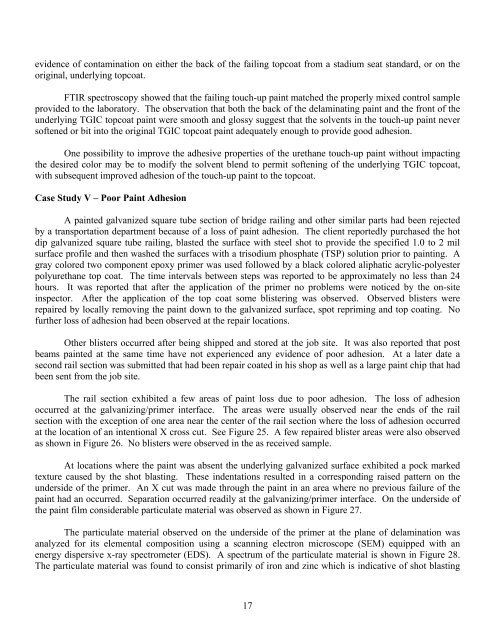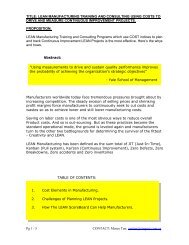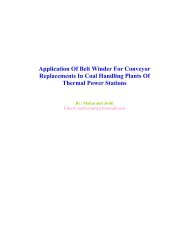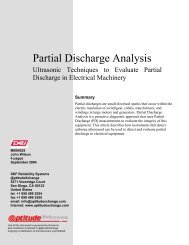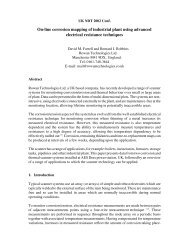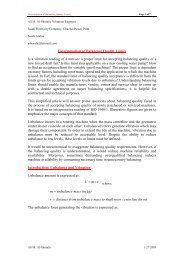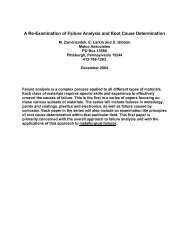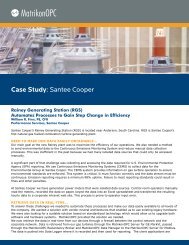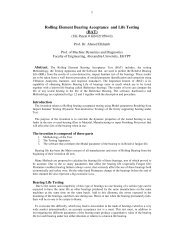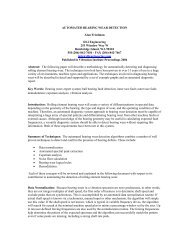Failure Analysis of Paints and Coatings - Plant Maintenance ...
Failure Analysis of Paints and Coatings - Plant Maintenance ...
Failure Analysis of Paints and Coatings - Plant Maintenance ...
Create successful ePaper yourself
Turn your PDF publications into a flip-book with our unique Google optimized e-Paper software.
evidence <strong>of</strong> contamination on either the back <strong>of</strong> the failing topcoat from a stadium seat st<strong>and</strong>ard, or on theoriginal, underlying topcoat.FTIR spectroscopy showed that the failing touch-up paint matched the properly mixed control sampleprovided to the laboratory. The observation that both the back <strong>of</strong> the delaminating paint <strong>and</strong> the front <strong>of</strong> theunderlying TGIC topcoat paint were smooth <strong>and</strong> glossy suggest that the solvents in the touch-up paint nevers<strong>of</strong>tened or bit into the original TGIC topcoat paint adequately enough to provide good adhesion.One possibility to improve the adhesive properties <strong>of</strong> the urethane touch-up paint without impactingthe desired color may be to modify the solvent blend to permit s<strong>of</strong>tening <strong>of</strong> the underlying TGIC topcoat,with subsequent improved adhesion <strong>of</strong> the touch-up paint to the topcoat.Case Study V – Poor Paint AdhesionA painted galvanized square tube section <strong>of</strong> bridge railing <strong>and</strong> other similar parts had been rejectedby a transportation department because <strong>of</strong> a loss <strong>of</strong> paint adhesion. The client reportedly purchased the hotdip galvanized square tube railing, blasted the surface with steel shot to provide the specified 1.0 to 2 milsurface pr<strong>of</strong>ile <strong>and</strong> then washed the surfaces with a trisodium phosphate (TSP) solution prior to painting. Agray colored two component epoxy primer was used followed by a black colored aliphatic acrylic-polyesterpolyurethane top coat. The time intervals between steps was reported to be approximately no less than 24hours. It was reported that after the application <strong>of</strong> the primer no problems were noticed by the on-siteinspector. After the application <strong>of</strong> the top coat some blistering was observed. Observed blisters wererepaired by locally removing the paint down to the galvanized surface, spot repriming <strong>and</strong> top coating. N<strong>of</strong>urther loss <strong>of</strong> adhesion had been observed at the repair locations.Other blisters occurred after being shipped <strong>and</strong> stored at the job site. It was also reported that postbeams painted at the same time have not experienced any evidence <strong>of</strong> poor adhesion. At a later date asecond rail section was submitted that had been repair coated in his shop as well as a large paint chip that hadbeen sent from the job site.The rail section exhibited a few areas <strong>of</strong> paint loss due to poor adhesion. The loss <strong>of</strong> adhesionoccurred at the galvanizing/primer interface. The areas were usually observed near the ends <strong>of</strong> the railsection with the exception <strong>of</strong> one area near the center <strong>of</strong> the rail section where the loss <strong>of</strong> adhesion occurredat the location <strong>of</strong> an intentional X cross cut. See Figure 25. A few repaired blister areas were also observedas shown in Figure 26. No blisters were observed in the as received sample.At locations where the paint was absent the underlying galvanized surface exhibited a pock markedtexture caused by the shot blasting. These indentations resulted in a corresponding raised pattern on theunderside <strong>of</strong> the primer. An X cut was made through the paint in an area where no previous failure <strong>of</strong> thepaint had an occurred. Separation occurred readily at the galvanizing/primer interface. On the underside <strong>of</strong>the paint film considerable particulate material was observed as shown in Figure 27.The particulate material observed on the underside <strong>of</strong> the primer at the plane <strong>of</strong> delamination wasanalyzed for its elemental composition using a scanning electron microscope (SEM) equipped with anenergy dispersive x-ray spectrometer (EDS). A spectrum <strong>of</strong> the particulate material is shown in Figure 28.The particulate material was found to consist primarily <strong>of</strong> iron <strong>and</strong> zinc which is indicative <strong>of</strong> shot blasting17


